
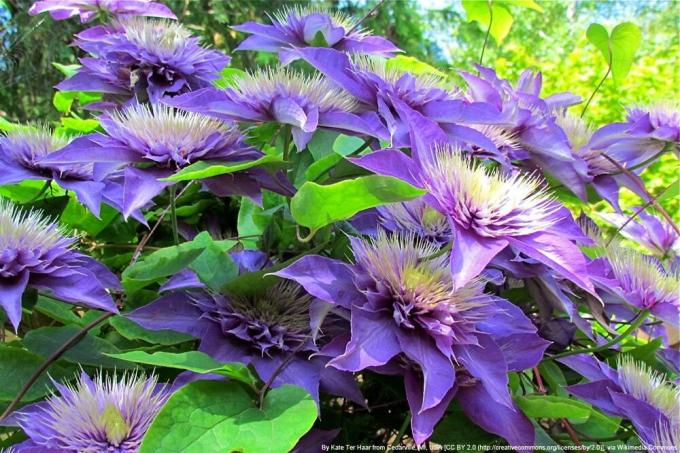
Table of contents
- growth
- blossom
- Location
- Floor
- plant out
- Bucket attitude
- Fertilize
- Pour
- pruning
- diseases and pests
- hibernate
Breeders have actually managed to enhance the beauty of the already adorable clematis. The hybrid variety 'Multi Blue' is one such strain created. Its tendrils are covered with a flood of lavender blue flowers. The numerous pointed petals give each individual double flower an exceptionally beautiful appearance. And with good care, this clematis will bloom for a second time in late summer.
growth
The 'Multi Blue' is, typically Clematis, a climbing plant that quickly gains height. A mature clematis of the 'Multi Blue' variety can reach a height of up to 2.5 m. With regular pruning, it develops a beautifully branched shape with strong climbing tendrils. However, these thin tendrils cannot stand up by themselves and need something nearby to hold on to, a special jungle gym, wall, tree, etc. Ä. Clematis sheds its leaves in winter to sprout fresh in spring.
blossom
The filled blue-violet flower is the special feature of this variety. With a diameter of around 8 to 12 cm, they are not among the largest clematis flowers, but their appearance makes them particularly striking. The outer leaves form a star-shaped outline around the flower head. From this, in turn, the filling unfolds, like a water lily. Countless small and fringe-like leaves gradually open. The first flowering phase of 'Multi Blue' begins in June. This clematis blooms again in late summer, but not always with the fringed leaves. It's just a pity that the flowers don't spread any scent.
Location
This clematis likes to climb in sunny to partially shaded places, only its roots prefer continuous shade. In order for all parts of this plant to be satisfied, the owner needs a little help. The clematis is planted in a predominantly sunny location and at the same time its roots are protected from the sun:
- approx. Plant 10 cm deeper than normal
- an approx. Apply a 10 cm layer of mulch
- alternatively plant ground cover
- or plant other perennial plants nearby that cast shade
Tip:
The location should also be protected from the wind, as strong winds can tear the tendrils of the clematis from their support structure.
Floor

The roots of the clematis grow deep into the ground. In a deeply loosened soil, this growth occurs effortlessly. On the one hand, sandy, humus-rich soil is nutritious for the clematis, on the other hand, water can seep away easily. If the soil is too loamy, it should be loosened up with some sand and stones to prevent waterlogging. On the other hand, if the soil is too sandy, it cannot hold water and should therefore be mixed with some potting soil. A drainage layer of sand and gravel facilitates the seepage of excess water.
plant out
The clematis 'Multi Blue' is hardy and is ideal for an outdoor location. It is commercially available in pots and must be planted out in the garden at home. If you want to green a larger area, two clematis per meter are necessary.
- Place the pot with the clematis in a bucket of water for about 10 minutes.
- Prepare the ground. It should be well loosened.
- Dig a planting hole about twice the size of the current pot.
- Carefully remove the plant from the pot. Don't pull on vines! Hold the plant overhead, then slowly pull the pot up while holding the plant ball with your other hand.
- Place the clematis in the prepared hole, about 10 cm deeper than it was previously in the pot.
- Fill the gap with soil and press it down well.
- Form a pouring wall to facilitate pouring.
- Water the planted clematis generously.
- Offer her a suitable climbing aid right at the beginning.
- Keep watering the plant for several weeks after planting. Orientate yourself on the current weather conditions.
Tip:
If the clematis is planted on a house wall, the distance to the wall should be about 10 to 15 cm. This way enough air gets in and moisture can evaporate better.
Bucket attitude

Climbing plants are also ideal for greening balconies and terraces. However, the pot in which the clematis is sold commercially is too small for this purpose. It must be transplanted into a sufficiently large bucket. In a large container, the clematis has sufficient substrate available. Two more clematis can even be planted to achieve even more lush and dense growth.
- plant pot with min. Use 25 liters volume
- many large bottom holes required
- an approximately 8 cm high drainage layer made of gravel or grit prevents standing moisture
- high-quality potting soil provides sufficient nutrients
- fertilize regularly during the flowering phase
- Shade roots, with low underplanting
- attach stable climbing aid to the bucket with many struts
- potted plants also need pruning
- a sheltered spot is important in winter
- alternatively: wrap the bucket with plant fleece
- replace the old soil with new ones every 3 to 4 years
Tip:
When repotting, reduce the root area by about a third. This stimulates the formation of new roots.
Fertilize
The clematis needs plenty of nutrients and trace elements for new growth in spring and for the formation of flowers. Regular fertilizer application during this time ensures strong tendrils and plenty of flowers. Horn shavings are a good long-term fertilizer and should be worked into the soil in good time before the flowering phase. It takes a little time for the microorganisms in the soil to release the nutrients it contains. Fertilizer for roses or special fertilizer for climbing plants also gives them the growth elements they need and should be added to the irrigation water until mid-August.
Pour
Clematis that have been growing in the garden for a number of years have developed their roots to such an extent that the natural moisture in the soil is sufficient for their needs. Only when the summer is particularly dry do they not find enough water to develop their blooms. This is because they absorb nutrients that they absolutely need for growth via water. During this growing season, the soil must never dry out completely. As soon as the top layer has dried, you must supply the clematis with fresh water.
Young clematis have to be watered again and again, the supply from their roots is not always enough. However, clematis that grow in tubs need to be watered more often. Even if the days are not too hot, the soil in the bucket loses moisture quickly.
When watering, however, it is essential to ensure that no waterlogging occurs. If the soil conditions tend to waterlogging, soil improvement measures are strongly recommended. When it comes to watering, it is also better to give her about water every day, once plenty of it.
pruning

Clematis are pruned depending on when they bloom. Clematis 'Multi Blue' belongs to the clematis of the so-called second cut group. After the first flowering in summer, the climbing plant is only cut back slightly. Above all, their withered flowers must be removed so that they do not use their strength for seed formation. The energy saved benefits the second flowering in late summer. In spring, before the new shoots, the 'Multi Blue' is thinned out again and all shoots are cut back to about 1 to 1.5 m.
If the clematis does not yet have many main branches, it is also possible to cut it back to about 50 cm. It drives out again, then more branched and stronger. Due to the rapid growth, it can soon be admired in full height and now also in width.
diseases and pests
Clematis, located in the appropriate location and properly cared for, is hardly susceptible to diseases and pests. 'Multi Blue' is also resistant to the dreaded clematis wilt. Powdery mildew can occur and must be combated in good time. Heavily infested tendrils should be cut off and disposed of with the residual waste.
Voles like clematis and like to snack on their roots. A wire mesh around the root ball, already attached when planting, keeps the small annoying rodents at a distance.
hibernate
The Clematis 'Multi Blue' is hardy down to -20 degrees Celsius. It will therefore be able to survive even harsher winters outdoors. Nevertheless, a light winter protection cannot hurt, especially with young plants. Cut off fir branches are ideal, which are stuck into the ground around the clematis to protect them from cold winds. In the spring, when new growth begins, the fir branches can be removed again. Pot dwellers need extra protection in winter, even if the 'Multi Blue' is hardy. Heavy frosts penetrate quickly into the potting soil and can lead to frostbite on the roots. On such cold days and nights, the bucket should be kept in a protected, frost-free room. If this is not possible, the bucket must be wrapped in fleece to mitigate the cold somewhat.
 garden editorial
garden editorial I write about everything that interests me in my garden.
Learn more about clematis
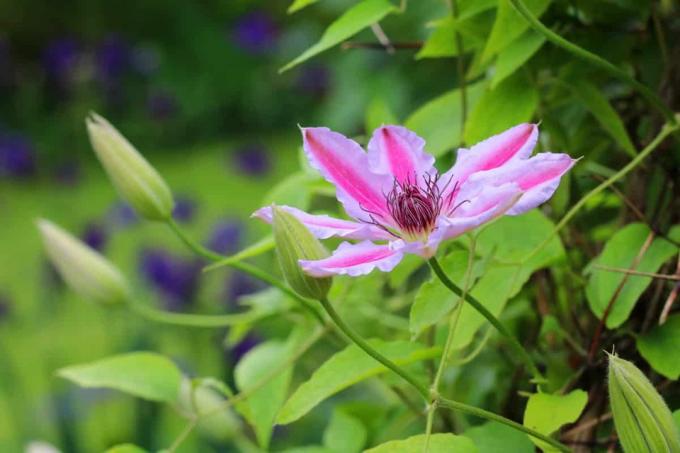
Lice, beetles & co: common clematis pests
Above and below ground there are many pests that can pose a threat to clematis. Without suitable countermeasures, some pests can damage a magnificent perennial so much within a few days that it dies.
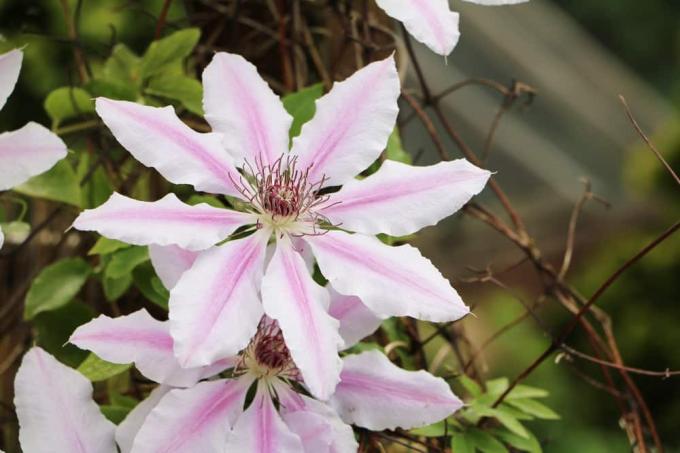
Pruning clematis: Instructions for late and early flowering varieties
Clematis is known and loved for its diverse flower shapes and colors. The plants, also known as clematis, are extremely decorative plants that can be used in many places in the garden to green trellises, pergolas, arbors and walls.

Clematis gets brown leaves - combat clematis wilt
Clematis wilt is a menacing disease that occasionally afflicts clematis. Especially the popular, large-flowered hybrids are being swept away at high speed. Left to its own devices, the clematis is helplessly at the mercy of the fungal pathogen. However, with the help of her owner, she is able to survive.
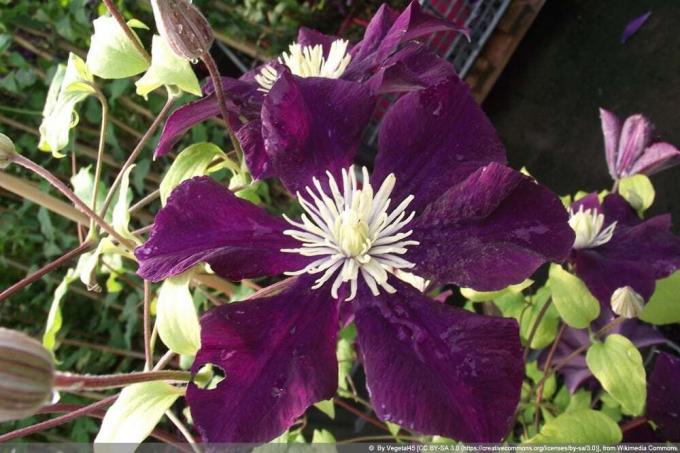
Clematis 'Warszawska Nike' Warsaw Night - care and pruning
The Clematis 'Warszawska Nike' Warsaw Night scores with its flowers. With the easy-care climbing plant you definitely get an eye-catcher in the garden. Only the cut is a bit difficult and requires courageous access. More about this is here.
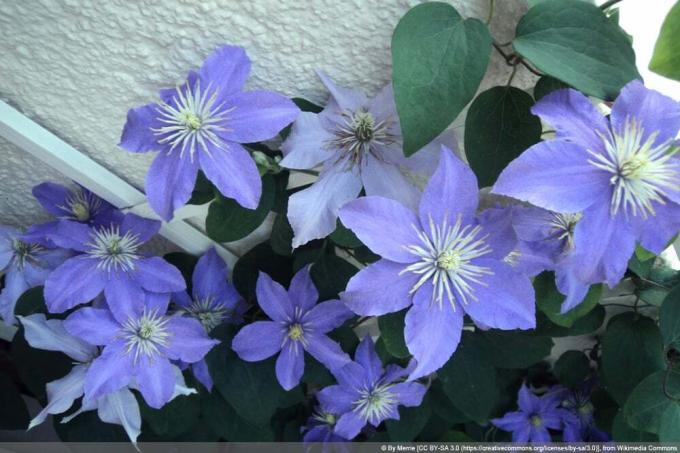
Clematis 'Justa' clematis - profile, care and cutting
Clematis 'Justa' clematis is a dwarf variety that has strong growth. In the summertime, the plant adorns itself with beautiful purple flowers that can also shine light blue. The clematis grows climbing and can reach a considerable height.

Clematis 'Nelly Moser' - pruning and care from A-Z
The clematis 'Nelly Moser' inspires with delicate pink flowers. A strong violet central stripe on each petal and the red stamens add harmonious color accents. In May and June, it unleashes a veritable explosion of flowers. With proper care, it also gives away a second bloom.

